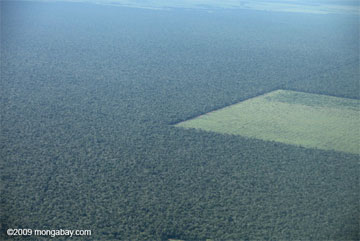Amazon rainforest ‘is very close to a tipping point’
The Amazonian apocalypse is just around the corner, according to scientists gathered at the conference launching the International Year of Biodiversity. 
By Stephen Leahy PARIS, Feb 1 (Tierramérica).- The Amazon forest “is very close to a tipping point,” and if destruction continues, it could shrink to one third of its original size in just 65 years, warns Thomas Lovejoy, world-renowned tropical biologist. Climate change, deforestation and fire are the drivers of this potential Amazonian apocalypse, according to Thomas Lovejoy, biodiversity chair at the Washington DC-based Heinz Center for Science, Economics and the Environment, and chief biodiversity adviser to the president of the World Bank. Lovejoy laid out the scenario for participants at the Biodiversity Science Policy Conference in Paris last week, sponsored by UNESCO (United Nations Educational, Scientific and Cultural Organization), and marking the beginning of the UN’s International Year of Biodiversity. “The World Bank released a study that finally put the impacts of climate change, deforestation and fires together. The tipping point for the Amazon is 20 percent deforestation,” and that is “a scary result,” Lovejoy told Tierramérica in an interview. The study, “Assessment of the Risk of Amazon Dieback,” released Jan. 22, drew on the expertise of several international research institutions, including Japan’s Meteorological Research Institute, Britain’s Exeter University, Germany’s Potsdam Institute, Brazil’s Center for Weather Forecasting and Climate Change (CPET/INPE) and Earth3000. The results and analysis were reviewed by a blue-ribbon panel of internationally renowned scientists. Lovejoy, head of the committee responsible for this major scientific investigation, said the Amazon has already lost 17 to 18 per cent of its forests. Furthermore, “it has a remarkable hydrogeological system where the forest generates at least half of its own rainfall.” This literally means the rainforest makes its own rain, but it also brings rainfall to many areas outside of the Amazon, including the central-western Brazilian state of Mato Grosso and northern Argentina, he said. What the study shows for the first time is the combination of global warming on a path to reach two degrees Celsius, deforestation of roughly 20 percent of the original forest, and forest fires that undermine the Amazon’s unique hydrogeological system. The Amazonian south and southeast will receive much less rainfall. Less moisture means those areas will be more prone to fires, which not only destroy the forest but also further dry out the surrounding forest – all of which reduces the Amazon’s ability to produce rain. The process becomes a self-reinforcing feedback loop. “The forest eventually converts to cerrado (the Brazilian savanna) after a lot fire, human misery, loss of biodiversity and emission of carbon into the atmosphere,” said Lovejoy. …